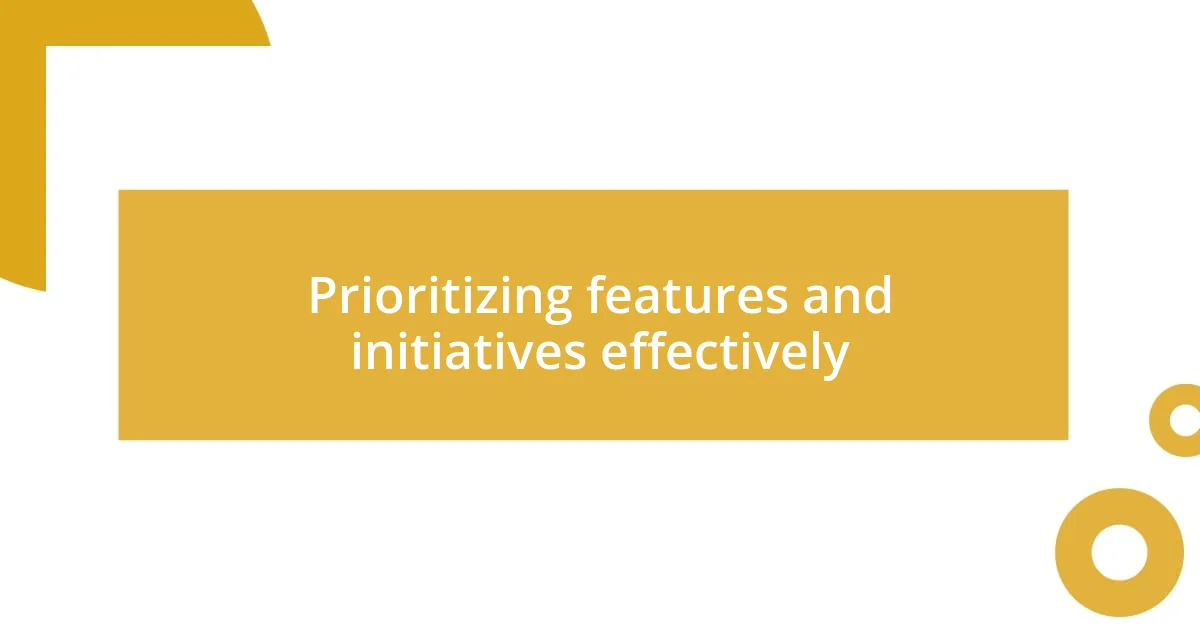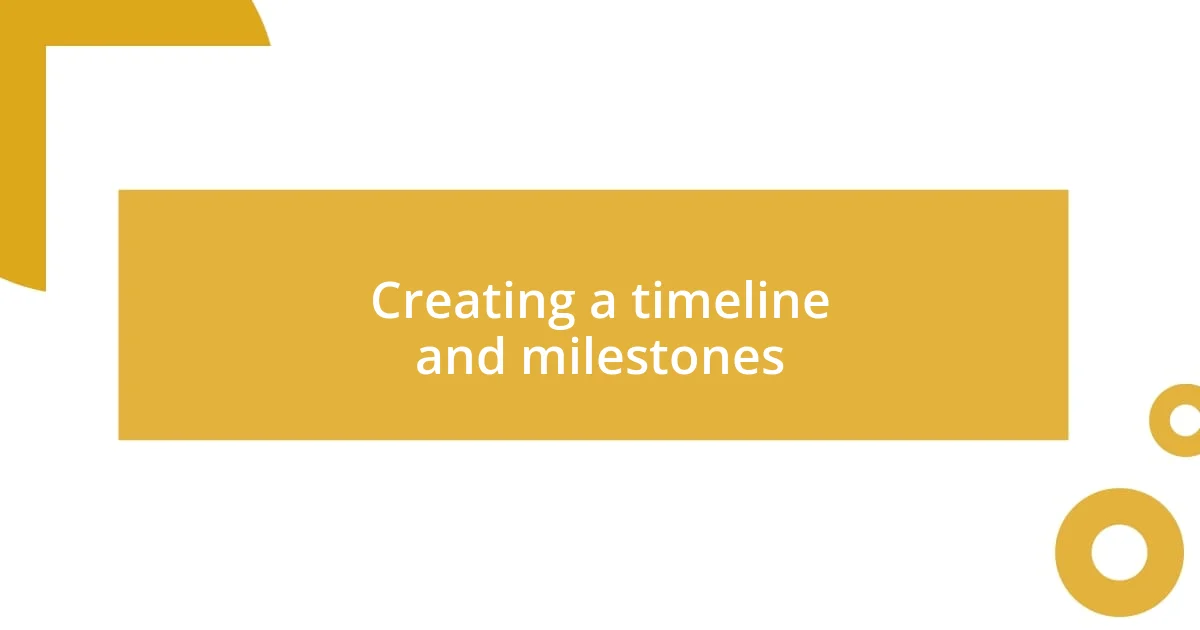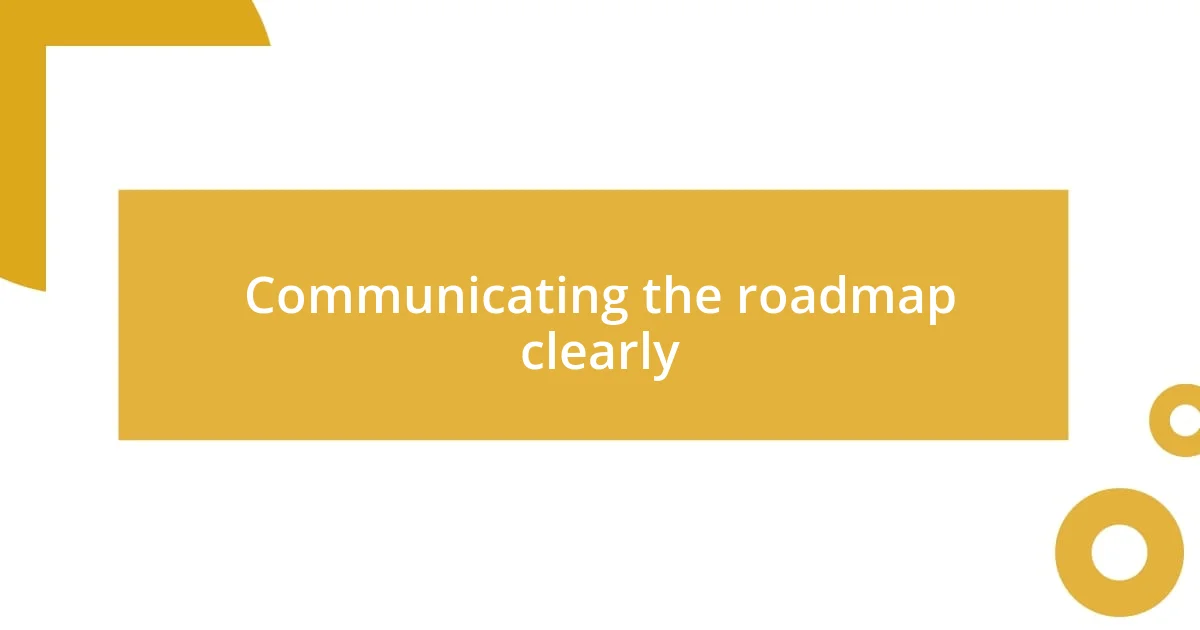Key takeaways:
- Product roadmaps align team members toward common goals, enhance accountability, and manage stakeholder expectations effectively.
- Defining a clear product vision and measurable goals fosters team alignment and allows for adaptability as market conditions change.
- Prioritization methods like MoSCoW and RICE, along with realistic timelines and clear communication, are essential for successful product development and team engagement.

Understanding product roadmaps importance
When I first encountered product roadmaps, I was amazed at how they serve as a guiding star, aligning all team members toward common goals. It’s like having a shared vision, ensuring that every stakeholder knows where we’re headed and why it matters. Have you ever felt lost in a project? That’s where a roadmap comes in handy—transforming confusion into clarity.
Think about the last time you launched a product or feature. Without a roadmap, I often found myself wondering if we were all on the same page, which led to miscommunication and wasted efforts. A well-structured roadmap not only helps in prioritizing tasks but also fosters a sense of accountability across the team. It reminds us that every small step we take contributes to a larger narrative.
Moreover, I’ve realized how crucial product roadmaps are for managing expectations with customers and stakeholders. They provide a timeline that helps everyone envision when to anticipate new features or updates. Have you ever had to explain a delay in project delivery? It’s far easier when you can point back to a roadmap, illustrating that while the journey may have shifted, the destination remains clear.

Defining product vision and goals
Defining a product vision is like charting the course for a journey that involves everyone on the team. I still remember the first time I sat down with my colleagues to hammer out our product vision; it felt invigorating to see everyone’s ideas flow together. Establishing clear goals connected to that vision can provide a solid foundation, ensuring all efforts contribute meaningfully to our mission.
When defining your product vision and goals, consider these key points:
- Clarity: Articulate what you want to achieve in a way everyone understands.
- Measurable Goals: Establish specific, quantifiable objectives that allow you to track progress.
- Alignment: Ensure team members resonate with the vision and can connect their tasks to it.
- Adaptability: Be prepared to refine your goals as market conditions or feedback dictate new directions.
- Long-Term Vision: While immediate goals are essential, don’t lose sight of where you ultimately want to take your product.
Reflecting on my experience, I’ve found that when we revisit our product vision regularly, it energizes us and reminds us of our purpose, making the challenging days feel worthwhile.

Prioritizing features and initiatives effectively
Prioritizing features and initiatives can be one of the more challenging aspects of product development. From my experience, we often had to balance the desires of various stakeholders against the actual needs of users. I remember a time when our team was flooded with feature requests. It felt overwhelming, yet focusing on user impact and feasibility helped narrow the list significantly. By using tools like the MoSCoW method—where we categorized features as Must-haves, Should-haves, Could-haves, and Won’t-haves—we successfully streamlined the decision-making process, ensuring we concentrated on what truly mattered.
Another technique I’ve employed is the RICE scoring model, which stands for Reach, Impact, Confidence, and Effort. I still recall my apprehension the first time we used it, but it really opened my eyes to a structured way of evaluating initiatives. By assigning scores to each potential feature, I could see where to invest our time effectively. This data-driven approach not only clarified our priorities but also helped bridge discussions with stakeholders, making it easier to justify why we were focusing on particular initiatives.
At the end of the day, prioritization is as much an art as it is a science. I’ve often leaned into team discussions for input, which has led to richer insights. Engaging the whole team fosters a sense of ownership over the roadmap. Have you ever felt the energy shift when everyone is on board? It’s palpable, and honestly, it makes tackling future projects feel like a collective adventure rather than an uphill battle.
| Prioritization Method | Description |
|---|---|
| MoSCoW | Categorizes features into Must-haves, Should-haves, Could-haves, and Won’t-haves to simplify decision-making. |
| RICE | Scores potential features based on Reach, Impact, Confidence, and Effort for effective evaluation. |

Creating a timeline and milestones
Creating a detailed timeline and setting milestones is essential for keeping the product roadmap on track. I can’t tell you how often I’ve been in situations where deadlines felt nebulous, making it hard to rally the team efficiently. One time, outlining specific milestones turned what seemed like an endless journey into smaller, manageable steps that felt achievable. We celebrated each milestone, reminding ourselves of the progress we were making, which kept morale high.
It’s also crucial to make sure those milestones are realistic. I recall an ambitious deadline we set for a major release that didn’t factor in the complexities of some new features. Facing mounting pressure, we had to recalibrate our expectations. Learning from that experience, I now advocate for involving the entire team when we create timelines. It not only enhances accountability but also creates a shared understanding of what we can realistically achieve.
Lastly, don’t underestimate the emotional impact of a well-structured timeline. Have you ever experienced the thrill of crossing off tasks on your list? That feeling of accomplishment can significantly boost motivation. I remember when our team successfully met a critical milestone ahead of schedule; the shared excitement transformed our workflow. It’s moments like these that remind us: a timeline isn’t just a plan—it’s a powerful motivator.

Communicating the roadmap clearly
Clear communication of the product roadmap is crucial for ensuring everyone is aligned and informed about our direction. I’ve found that using visual tools—like Gantt charts or Kanban boards—can transform complex information into digestible formats. I remember introducing a simple board during a team meeting; it sparked a lively discussion and made everyone feel more connected to our goals. Have you ever felt the power of a great visual in simplifying a tough topic? It’s almost like having a shared language.
When sharing the roadmap, it’s important to tailor the messaging based on your audience. For instance, I often adjust my approach depending on whether I’m speaking to developers, marketers, or executives. I distinctly recall a time I presented a roadmap to our sales team, focusing on how upcoming features would specifically benefit clients. Their engagement in that moment was incredible! They weren’t just passive listeners; they became advocates for the changes we were implementing.
Moreover, fostering an open dialogue is key. I make it a point to encourage feedback during presentations. I vividly recall a feedback session that led us to rethink an entire feature because the sales team highlighted a customer pain point we had overlooked. The excitement around those discussions reignites my passion for our work. Do you find that creating a culture where team input is welcomed helps everyone feel invested in the outcome? I’ve certainly seen the positive effects in my experience, as it builds a stronger sense of collaboration and ownership across the board.















